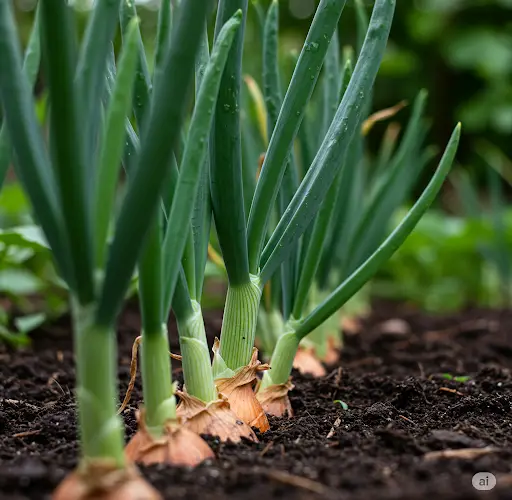Onions are among the most popular and rewarding vegetables to grow in a home garden. Whether you’re cultivating them for fresh salads, cooking, or long-term storage, getting a strong start is the key to success. A healthy onion harvest begins with proper planting, especially if you’re working with seedlings rather than seeds.
There’s a specific method many experienced gardeners swear by when it comes to transplanting onion seedlings. It’s simple, effective, and promotes quick root development, vigorous growth, and disease resistance. When done right, this approach can make all the difference in your onion crop.
Why Seedling Planting Matters
Onion seedlings—either grown from seed indoors or purchased from a nursery—are typically delicate, with narrow stems and thin roots. If planted too shallow, they can dry out or become unstable. If planted too deep or in compacted soil, they may rot or struggle to establish. The technique you use directly impacts how fast the seedlings adapt and how well they mature.
This method combines strategic planting depth, natural root stimulants, and soil preparation to ensure your onion seedlings settle in quickly and thrive.
Step 1: Preparing the Soil for Root Success
Onions prefer light, well-drained, fertile soil that’s rich in organic matter. Before planting, loosen the soil to a depth of 15–20 cm (6–8 inches), and mix in the following amendments:
-
Aged compost or well-rotted manure – improves structure and feeds young roots
-
Wood ash or bone meal – adds phosphorus and potassium for root development
-
A handful of sand – if your soil is heavy clay, this improves drainage
Rake the soil to a fine texture and level the surface. Avoid fresh manure or overly rich nitrogen fertilizers, as these can encourage excessive leaf growth at the expense of bulb formation.
Step 2: Trim and Prepare the Seedlings
Before planting, inspect your onion seedlings. Trim the green tops to about 10–12 cm (4–5 inches) if they are very tall. This reduces transplant shock and encourages the plant to focus on root development.
Also, check the roots—if they are tangled or long, you can lightly trim the ends to stimulate new growth. Avoid damaging the base of the seedling, as this is the growth point.
Step 3: Use a Root-Stimulating Planting Dip
To help your onion seedlings take root faster, prepare a simple soaking solution using natural ingredients:
Root Stimulating Solution:
-
1 liter of lukewarm water
-
1 tablespoon of honey (natural root stimulator)
-
A pinch of baking soda (antifungal protection)
Soak the trimmed seedlings in this solution for 20–30 minutes before planting. Honey contains enzymes that support root growth and protect against fungal pathogens, while baking soda creates a mildly protective environment.
Step 4: Plant at the Right Depth and Spacing
Onions don’t like to be planted too deep. Here’s how to do it correctly:
-
Use a stick or dibber to make holes about 3–4 cm deep.
-
Space the seedlings about 10 cm (4 inches) apart in rows spaced 25–30 cm (10–12 inches) apart.
-
Insert each seedling gently, making sure only the roots and the base are covered with soil. The green part should remain exposed.
-
Press the soil gently around each seedling to eliminate air pockets.
Shallow planting allows the bulb to form above the soil line, which is essential for proper development and long-term storage.
Step 5: Water Immediately and Mulch Lightly
Water the seedlings immediately after planting using lukewarm water. This helps settle the soil around the roots and kick-starts growth. Keep the soil consistently moist, but not soggy, especially during the first two weeks.
Apply a light mulch layer—such as straw or finely chopped dry grass—around the base of the plants. This keeps the soil moist, suppresses weeds, and protects young seedlings from temperature fluctuations.
Ongoing Care for Strong, Healthy Onions
Once established, onion seedlings need consistent but moderate care:
-
Water once or twice a week, depending on weather and soil conditions.
-
Weed regularly, as onions dislike competition.
-
Feed with a balanced organic fertilizer every 3–4 weeks if growth appears slow.
-
Hill slightly around the base of the plant if bulbs start to lean.
Avoid over-fertilizing with nitrogen late in the season, as it can delay bulb formation and reduce storability.
The Visible Results
By following this method, onion seedlings quickly take root and grow upright with vibrant green tops. Strong root systems allow them to withstand dry spells, pests, and disease better than weakly planted counterparts.
Gardeners who use this approach often find their onions form more uniform bulbs with a firmer structure and better taste. The early care you invest pays off with a generous, healthy harvest.
Final Thoughts
Planting onion seedlings may seem straightforward, but small adjustments in technique can have a big impact. From preparing the soil and soaking in a root stimulator to planting at the right depth, each step supports faster rooting and stronger growth. Try this method in your garden and enjoy a reliable, high-quality onion crop season after season.



